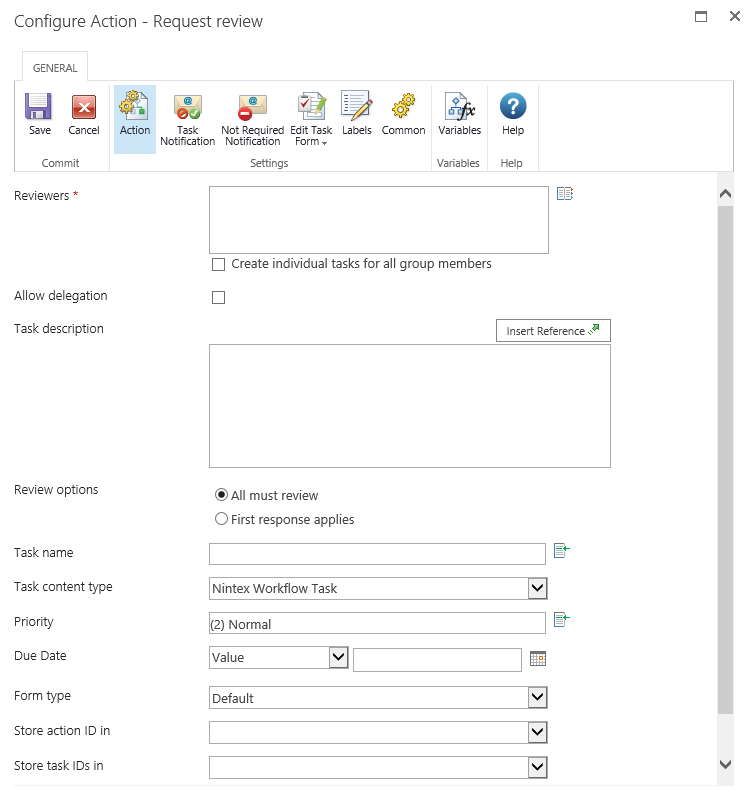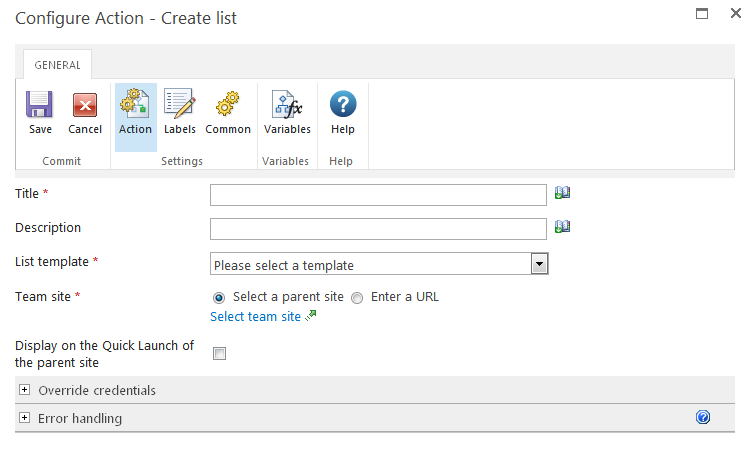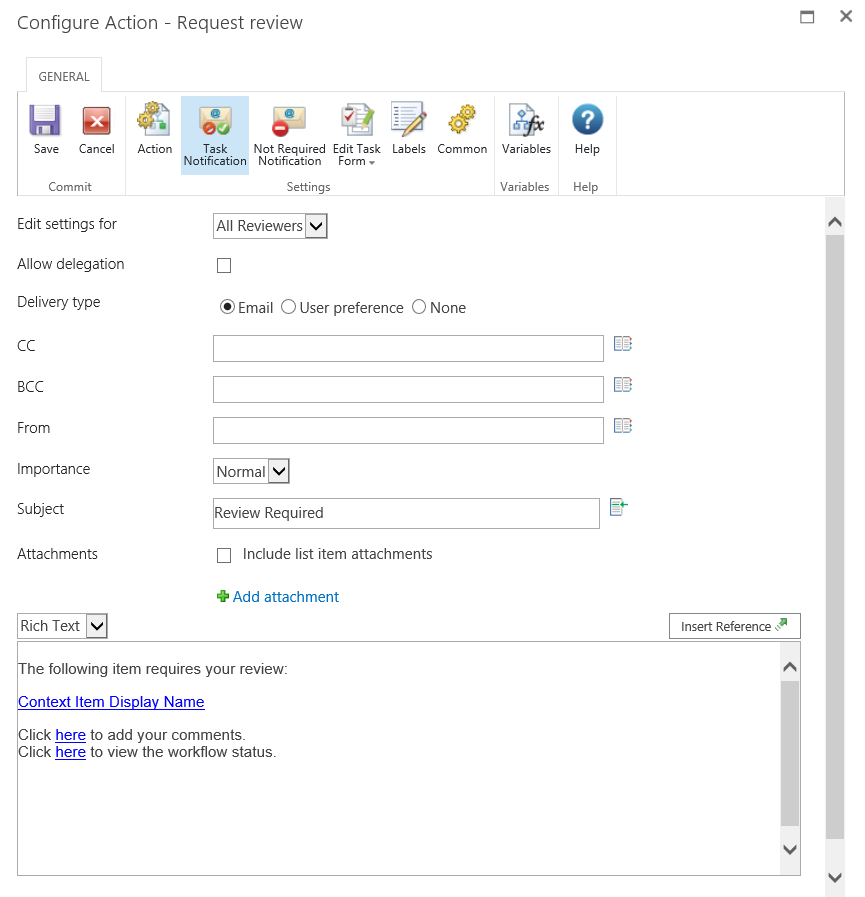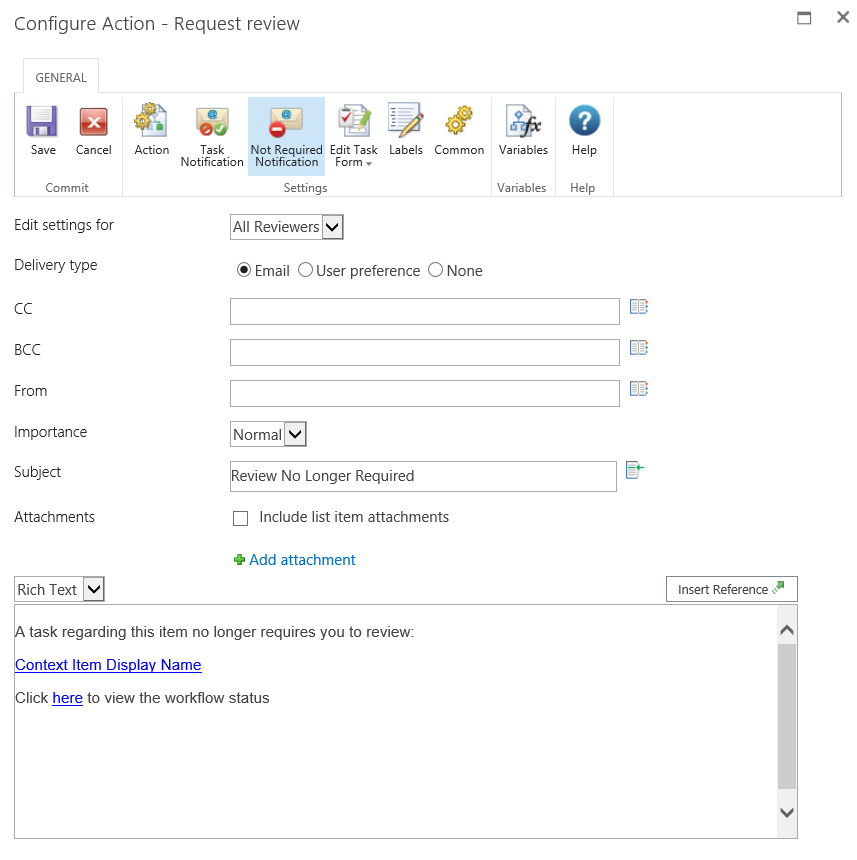
|
 |

|
 |

|
 |

|

|
This action is used to assign a task and send a notification to one or more users to review an item as part of the workflow. For more details on the review process please refer to Approving, Rejecting and Reviewing Items.
To use the workflow action:
-
Locate the action in Workflow Actions Toolbox (located on the left hand-side);
-
Click on the Category listings to reveal the actions; OR
-
Search for the action using a keyword.
-
Select the action, drag it onto the design canvas and drop it onto a design pearl.
Alternatively
-
Left-clicking the pearl, mouse-over Insert Action and then the Categories to reveal the actions, click the required action from the list.
To change the settings used by the action:
-
On the action’s title click the down arrow to activate a drop-down
-
Select Configure; OR
-
Double-click the action's icon.
For more information on the other options in the drop-down, please refer to the Getting started with the Nintex Workflow designer.

Options for this action
Ribbon Option: Action
Reviewers
The Reviewers list contains all users or groups that will be assigned the review task during the running of the published workflow.
Users can be entered directly by their username, email address or full name, and will be resolved where possible against the SharePoint user list.
In the case that a group is assigned the review task and Expand Groups is not selected, all users in that group will receive the task but the first response will represent the whole group. If Expand Groups is selected, an individual task will be assigned to every group member. Note that groups will only be expanded at one level. Groups within groups will not be expanded.
In order to search for the reviewers click on the address book icon to the right of the reviewers input box. The Select People and Groups dialog will appear.
Select People and Groups

The Select People and Groups dialog allows the workflow designer to search for and/or add users to the Reviewers list by one or more of the following methods:
- Internal Search: Entering a partial display name, email or user account name and clicking on the magnifying glass will provide a list of matching users and groups from SharePoint as well as Active Directory.
- External email address: Enter an external email address manually. Where possible Nintex Workflow will resolve this to an actual user account.
Create individual tasks for all group members
In the case when a group is assigned the task and Create individual tasks for all group members checkbox is:
- not selected, all users in that group will receive the task notification. The first respondent will represent the entire group.
- selected, an individual task will be assigned to every member of the group.
Groups will only be expanded to one level. Groups within groups will not be expanded.Users can be entered directly using their username, email address or full name and will be resolved where possible against the SharePoint user list or Active Directory.
Allow delegation
When this option is selected the assignee at runtime can delegate the task to another user. For more information, please refer to the Delegating Approval Tasks.
Allow LazyApproval
If LazyApproval has been enabled, the workflow can permit the assignees to use LazyApproval. Lazy Approval means that a task response can be registered when the assignee replies to a notification email or an automated OCS / Lync conversation. In a Request Review action, the users response will be used for the task comments. Changing the allow LazyApproval option on the 'Action' ribbon option is the same as changing the 'Allow LazyApproval' option for all assignees on the 'Task Notification' ribbon option. See the 'Task Notification' ribbon option section below for more information.
Task description
Allows entry of dynamic text that will display on the task response form. This can be used to communicate additional information about the task to the responding user. The description can be built up dynamically be using the Insert Reference function. For more information see Inserting reference fields.
Review options
There are two options that will determine which reviewers are required at runtime in case of multiple assigned users.
- All must review: Each user in the Reviewers list must review the item. The workflow will not proceed until a response has been received from each reviewer or reviewer's delegate.
- First response applies: The first response is registered and enables the workflow to continue. All other review requests will subsequently no longer be required and a no longer required notification will be sent to remaining reviewers if configured.
Task name
Allows the title of the task to be defined. This is the title that appears in a SharePoint task list. If left blank, the action title will be used by default.
Task content type
Allows a task content type other than the default to be used. This option will only display if an alternative content type is available on the site. Alternative content types are primarily used to enable custom task response forms.
Priority
Specifies the value that should be assigned to the priority flag for the task.
Due Date
Set a date for the task to be completed by. Note: When tasks appear in Nintex Mobile Apps, the tasks list will be sorted by this due date.
Form type
Choose which form type is presented to Reviewers. Choices are Default, InfoPath, or Custom.
Store Action ID in
Allows a unique identifier for the action to be stored in an Action ID workflow variable. This identifier can be used to link the action to Delegate Task and Task reminder actions. Please note that the Action ID does not correspond to the ID of the SharePoint task item that is created.
Store task IDs in
When the workflow runs, the ID given to each task that is created will be stored into an Integer, List Item ID or Collection workflow variable.
Item Permissions
Set user permissions to: Sets the user permission on the item.
When task is complete, set user permissions to: Sets the user permission on the item after the task has been completed.
Note: Setting the item permissions could be useful when the task is delegated, this will give the delegated user the necessary permissions to view the item.
Advanced Options: Complete tasks for all assignees when an outcome has been achieved
When an outcome is achieved, sets the % Complete value for "Not Required" tasks to 100%.
Ribbon Option: Task Notification

Edit settings for
Changing this setting from the default All Reviewers, allows the configuration of unique notification options for each Reviewer in the list.
Unless specifically configured, assignees will use the All Assignees settings. To override settings for a specific Reviewer, select their name from the drop down list.
Changes to All Reviewer will not affect users who are given custom settings.

Allow delegation
When this option is selected the assignee at runtime can delegate the task to another user. For more information, please refer to the Delegating Approval Tasks.
Allow Lazy Approval
If LazyApproval has been enabled, the workflow can permit the assignees to use LazyApproval. Lazy Approval means that a task response can be registered when the assignee replies to a notification email or an automated OCS / Lync conversation. In a Request Review action, the users response will be used for the task comments.
Delivery type
Delivery type is the method of delivering the notification to the recipients.
Available delivery options; None, Email, User preference or Instant Message (if enabled on the server). For information on User preference, please refer to Configuring user preferences.
If Allow LazyApproval is checked and Delivery type selected is IM. The option Send a conversation request to confirm if the user is available to respond will be available. Checking this option will ask the assignee if they are available to respond, if the assignee responds with "No", the Delivery type will be switched to Email and the assignee will receive a notification email instead.
If at anytime the assignee does not respond within 5 minutes to the automated OCS or Lync conversation, the conversation will end and a notification email to complete the tasks will be sent instead.
CC
The CC field sets read only users who will receive the notification. CC recipients are not able to respond to the tasks.
To set the CC field click on
to open the Select People and Groups configuration dialog
BCC
The BCC field sets read only users who will receive the email. BCC recipitants are not able to respond to the tasks. Other users addressed in the email via the To, CC and BCC fields will not be able to see any addresses in the BCC field. To set the BCC field, enter the account name, or alternatively, select the address book icon for additional options.
From
The From field sets the user or domain group that will appear as the sender of the message. This setting applies to emails only. If no From user or domain group is specified, the From address configured in Global Settings will be used.
Importance
The priority of the notification. This is only applicable when using email notifications.
Subject
The Subject is the title of the notification being sent. If an Instant Message is being sent it will be pre-pended to the body of the notification.
The Subject line can be typed manually or built up dynamically at runtime using the Insert reference fields button
.
Attachments
Allows file attachments to be added to the notification. You can specify multiple URLs by separating each URL with a semicolon. You can also specify multiple URLs by referencing a collection variable.
Files will not be received by a user when SMS or IM is selected as the delivery method. For information on User preference, please refer to Configuring user preferences.
Format
This sets the format of the email.
Selecting:
Notification body
The body of the notification will adapt depending on whether the Rich Text or Plain Text format is selected. Within the space provided enter the content for the notification as straight text, also available are Insert reference fields from within the workflow.
Ribbon Option: Not Required Notification
Use the Not Required Notification area to configure the notification that is sent when the user no longer needs to respond to the task. This can occur when:
- A task is assigned to multiple users but only one is required to respond.
- The workflow is terminated prior to the task being processed.
- An error occurs in the workflow at runtime.
